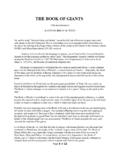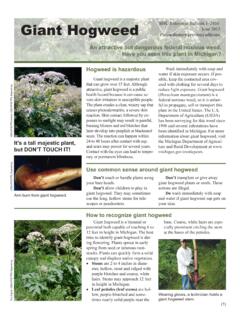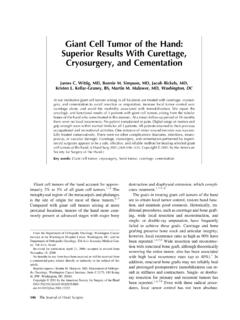Transcription of Giant Hogweed Factsheet - Final - NY Sea Grant
1 Giant Hogweed (Heracleummantegazzianum) - PoisonousInvader of the Northeast NYSG Invasive Species Factsheet Series: 07-1 Charles R. O Neill, Species SpecialistNew York Sea GrantFebruary 2007, Revised August 2009 New York s Sea Grant Extension Program provides Equal Program and Equal Employment Opportunities in associa-tion with Cornell Coop-erative Extension, Department of Agriculture and Department of Commerce, and cooperat-ing County Cooperative Extension York Sea GrantSUNY College at BrockportBrockport, NY 14420 Tel: (585) 395-2638 Fax: (585) 395-2466 heracleum mantegazzianumShould you be walking along a damp abandoned railroad right-of-way, a wet roadside ditch or a stream bank and stumble upon a plant that looks like Queen Anne s Lace with an attitude more than 10 feet tall with two-inch thick stems, flowers two or more feet across and leaf clusters as wide as you can stretch your arms stay clear!
2 You have just become one of an increasing number of New Yorkers who have met the state s most striking, and dangerous, invasive plant, the Giant Hogweed ( heracleum mantegazzianum ) and you absolutely do not want to touch it and take it home to the family. Giant Hogweed can make a case of poison ivy seem like a mild : Randy Westbrooks, USGSI ntroductionHistory and DistributionA member of the carrot and parsley family of plants (Apiaceae), Giant Hogweed is native to the Caucasus region of Eurasia. Because of its unique size and impressive flower head, the plant was originally introduced to Great Britain as an ornamental curiosity in the 19th century.
3 The plant is named after the mythological god, Hercules (he of robust size and strength). It was later transported to the United States and Canada as a showpiece in arboreta and Victorian gardens (one of the plant s first North American plantings of Giant Hogweed was in gardens near Highland Park in the City of Rochester, New York). It was also a favorite of beekeepers because of the size its flower heads (the amount of food for bees is substantial). A powder made from the dried seeds is also used as a spice in Iranian cooking. Unfortunately, as with so many invasive plants, Giant Hogweed escaped cultivation and has now become naturalized in a number of areas, including: Broome, Cattaraugus, Cayuga, Chautauqua, Erie, Genesee, Herkimer, Jefferson, Lewis, Livingston, Madison, Monroe, Nassau, Niagara, Oneida, Onondaga, Ontario, Orange, Orleans, Oswego, Putnam, Schuyler, Steuben, Sullivan, Tioga, Tompkins, Wayne, Wyoming, and Yates Counties in New York; Connecticut; the Giant Hogweed ( heracleum mantegazzianum ) is a member of the carrot or parsley family, Apiaceae (Umbelliferae).
4 Except for its size, the plant can be mistaken for a number of native, noninvasive plants such as cow parsnip ( heracleum lanatum), Angelica (Angelica atropurpurea), and poison hemlock (Conium maculatum). Of these, the plant most likely to be misidentified as Giant Hogweed is cow parsnip. A fourth, not so innocuous, invasive Giant Hogweed imposter found throughout North America is wild parsnip (Pastinaca sativa). Information on how to distinguish these Giant Hogweed wannabees from the real thing can be found later in this Hogweed is a perennial herb with tuberous root stalks. It survives from one growing season to another by forming perennating buds (surviving from season to season) and enduring a period of dormancy during the winter.
5 The plant develops numerous white flowers that form a flat-topped, umbrella-shaped head up to two and a half feet across, resembling Queen Anne s Lace on steroids. Flowers form from late-spring through mid-summer. Numerous (up to 100,000), half inch long, winged, flattened oval seeds form in late-summer. These seeds, originally green, turn brown as they dry and can be spread by animals, surface runoff of rain, or on the wind, establishing new colonies. Seeds can remain viable in the soil for up to 10 years. The plant s stems die in the fall and remain standing through the winter, topped with the huge, brown dead flower Hogweed s thick hollow stems are generally one to three inches in diameter but can reach four inches.
6 Also impressive are the plant s lobed, deeply incised compound leaves, which can reach up to five feet in width. The plant may grow to 15 to 20 feet in Hogweed can colonize a wide range of habitats but prefers rich, damp soil such as that found along abandoned railroad rights-of-way, roadside ditches, stream banks, or other moist disturbed areas. Because of this predilection for wet areas, the plant is considered to be an aquatic invasive sightings - August 2009 District of Columbia; Illinois; Maine; Maryland; Massachusetts; Michigan; Ohio; Oregon; Pennsylvania; Washington; Wisconsin; and the Canadian Provinces of British Columbia, New Brunswick, Ontario and Quebec.
7 Because of its public health hazard potential and, to a lesser extent, to its potential ecological impacts, Giant Hogweed is on the federal noxious weed list and several state lists of prohibited plant species. Biology and HabitatPhoto: Terry English, USDA APHIS PPQG iant Hogweed leaves can be up to five feet : Thomas B. Denholm, NJDA3 IDENTIFICIDENTIFICIDENTIFICIDENTIFICIDEN TIFICAAAAATIONTIONTIONTIONTIONAs mentioned earlier, there are several plants in New York and the Northeast that can be mistaken for gianthogweed. Key features for distinguishing these plants from Giant Hogweed are explained photographs can be found in tables on pages 4 and hogwGiant hogwGiant hogwGiant hogwGiant hogweedeedeedeedeed may grow to 15 to 20 feet in height.
8 Stems are 1 to 3 inches in diameter, but may reach 4inches. Stems are marked with dark purplish blotches and raised nodules. Leaf stalks are spotted, hollow,and covered with sturdy bristles (most prominent at the base of the stalk). Stems are also covered withhairs but not as prominently as the leaf stalks. Leaves are compound, lobed, and deeply incised; can reachup to 5 feet in width. Numerous white flowers form a flat-topped, umbrella-shaped head up to two and ahalf feet across. [Photos, page 4]Native CoCoCoCoCow parw parw parw parw parsnipsnipsnipsnipsnip, while resembling Giant Hogweed , grows to only five to eight feet tall.
9 The deeplyridged stems can be green or slightly purple, do not exhibit the dark purplish blotches and raised nodulesof Hogweed , and only reach one to two inches in diameter, contrasted with Hogweed stems which canreach three to four inches in diameter. Where Giant Hogweed has coarse bristly hairs on its stems andstalks, cow parsnip is covered with finer hairs that give the plant a fuzzy appearance. Both sides of theleaves exhibit these hairs but they are predominantly on the underside of the leaves. In contrast tohogweed s two to two and a half foot flower heads, cow parsnip flower clusters are less than a foot size difference carries over into leaf size with Hogweed s five foot, deeply incised leaves replaced byleaves that are less incised and only two to two and a half foot across.
10 [Photos, page 4]Native purpurpurpurpurple-stple-stple-stple-stp le-stemmed Angelicaemmed Angelicaemmed Angelicaemmed Angelicaemmed Angelica is more easily differentiated from Giant Hogweed by its smooth, waxygreen to purple stems (no bristles, no nodules), and its softball-sized clusters of greenish-white or whiteflowers, seldom reaching a foot across. As with cow parsnip, Angelica is much shorter than gianthogweed, usually no more than eight feet tall. Angelica leaves are comprised of many small leaflets andseldom reach more than two feet across. [Photos, page 4]PPPPP oison hemlocoison hemlocoison hemlocoison hemlocoison hemlockkkkk, a non-native biennial, is also shorter than Giant Hogweed , growing to only four to ninefeet in height.









